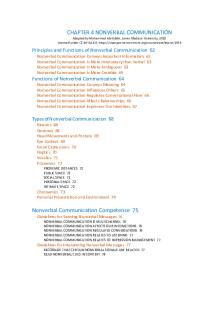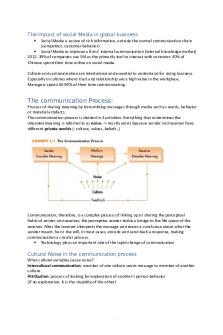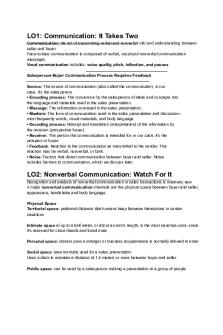Ethical Communication - Chapter 4 Summary (Lannon) - White Teeth PDF

| Title | Ethical Communication - Chapter 4 Summary (Lannon) - White Teeth |
|---|---|
| Course | StuDocu Summary Library EN |
| Institution | StuDocu University |
| Pages | 2 |
| File Size | 47.4 KB |
| File Type | |
| Total Downloads | 63 |
| Total Views | 126 |
Summary
Download Ethical Communication - Chapter 4 Summary (Lannon) - White Teeth PDF
Description
Ethical Communication - Chapter 4 Summary (Lannon) Incentives to not tell the whole truth often exist when it comes to advertising, only emphasizing the parts that are beneficial about your product and ignoring the negative parts. But, is this ethical? Ensuring that you are being ethical is not about doing things right, but more about doing the right thing. Unethical communication occurs more often than you would think. It does not always involve the people in suits at the top of the company but can be on more of a personal level like when someone exaggerates things on their resume to land a good job. The line between being ethical and making money can sometimes be hard to walk. For example, does an engineering design a product to the best quality making it cost twice as much, or do they use a little less quality and be able to sell the product? Production vs. safety is often the center of company disagreements. There are many different reasons that some people participate in unethical communication and pressure from social settings or at the workplace is a major contributor. Being a “team player” or talking “off the record” often leads people to feeling forced or pressured into acting unethical. There are instances where when working in a group forces people to not do the right thing, which is called groupthink. It can often be difficult because people do not want to disrupt team chemistry and be “that guy” so instead they will ignore possible issues. Sometimes companies or employees communicate in manners that are not fully true or with hidden intentions. They may leave out things that the public should know, such as the food industry labeling food so that no genetically altered ingredients would be assumed.
Conflicts of interest,
exaggeration, data fabrication, usage of pictures to conceal the truth, and electronic info misusage are all examples of communication abuse. Obligations to different parties are often at the center of the ethics controversy. Do you want to watch out for your own interests? Your client’s ? What about your company’s? Coworkers? Society? The list can go on and on. Attempting to satisfy all of the obligations is usually not possible making us decide where our primary obligations lie. Balancing obligations, ideals (what you stand for), and their possible consequences (results of your actions) comprise reasonable criteria for ethical judgment. In making decisions regarding ethics, there will more often than not be difficult decisions on difficult questions. There are several laws that regulate workplace communication. Some examples include laws against deception in court, intentionally falsely attacking anyone verbally, copyright laws, trade secret laws, and fraudulent advertising laws. Plagiarism is something that occurs when you take someone else’s ideas, words, or work without giving credit or citing them. It happens much more frequently
with the spread of the internet and oftentimes is done by accident - for example because of a source being forgotten. Deciding if and when to come forth about possible ethical no-no’s can be a complicated issue. There are oftentimes tough side-effects that come with blowing the whistle, including being fired, forced to resign, or bringing the knowledge to the public’s eyes. While now there are some laws that help back up employees who report their bosses or companies, there are still large uphill battles to be fought....
Similar Free PDFs

White Teeth Summary
- 5 Pages

Chapter 4 Nonverbal Communication
- 19 Pages

White Fang -Summary
- 5 Pages

White Noise Themes - Summary
- 6 Pages

Chapter 4 - Summary Criminology
- 5 Pages
Popular Institutions
- Tinajero National High School - Annex
- Politeknik Caltex Riau
- Yokohama City University
- SGT University
- University of Al-Qadisiyah
- Divine Word College of Vigan
- Techniek College Rotterdam
- Universidade de Santiago
- Universiti Teknologi MARA Cawangan Johor Kampus Pasir Gudang
- Poltekkes Kemenkes Yogyakarta
- Baguio City National High School
- Colegio san marcos
- preparatoria uno
- Centro de Bachillerato Tecnológico Industrial y de Servicios No. 107
- Dalian Maritime University
- Quang Trung Secondary School
- Colegio Tecnológico en Informática
- Corporación Regional de Educación Superior
- Grupo CEDVA
- Dar Al Uloom University
- Centro de Estudios Preuniversitarios de la Universidad Nacional de Ingeniería
- 上智大学
- Aakash International School, Nuna Majara
- San Felipe Neri Catholic School
- Kang Chiao International School - New Taipei City
- Misamis Occidental National High School
- Institución Educativa Escuela Normal Juan Ladrilleros
- Kolehiyo ng Pantukan
- Batanes State College
- Instituto Continental
- Sekolah Menengah Kejuruan Kesehatan Kaltara (Tarakan)
- Colegio de La Inmaculada Concepcion - Cebu










